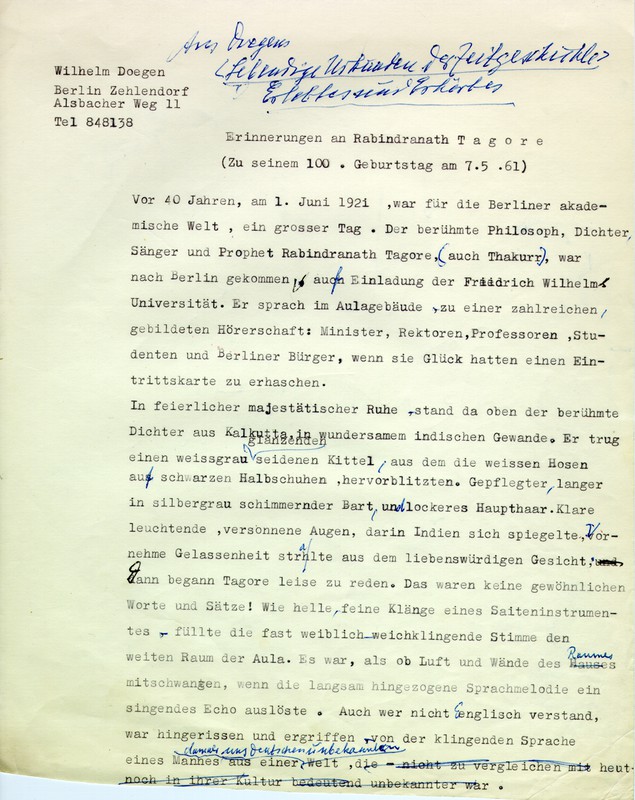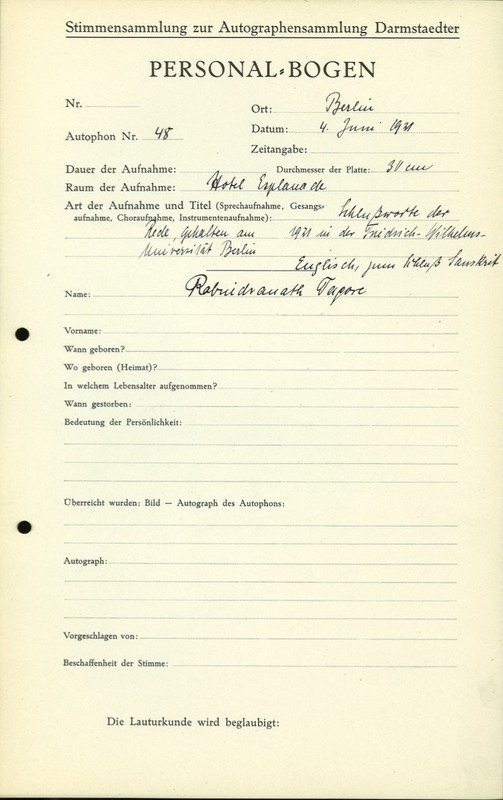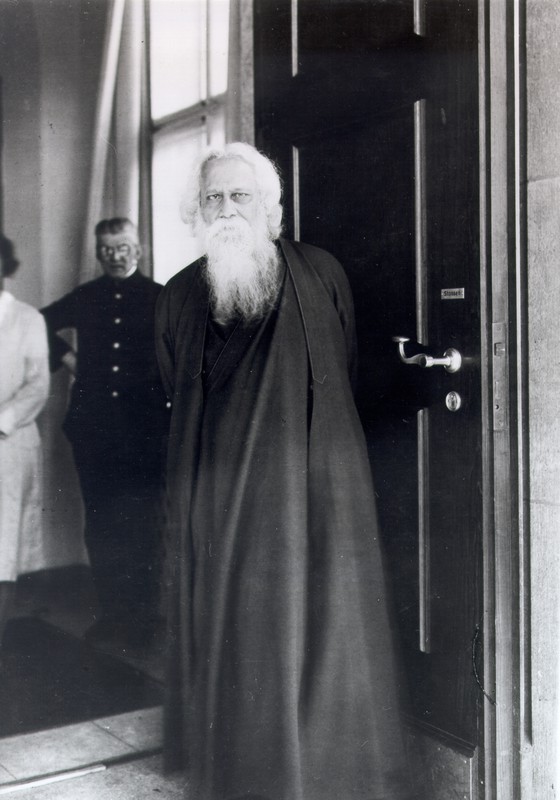Rabindranath Tagore Example from the “Famous People” Collection
The recording of the Bengali poet, writer and philosopher Rabindranath Tagore (or Thakur), 1861-1941, is not only marked Aut 48, showing it to be part of the collection of recordings of famous people’s voices; it is also the only shellac record in the Sound Archives to be marked LP 1. Wilhelm Doegen and the chemist Ludwig Darmstaedter set up the so-called “Voice Collection of the Darmstaedter Autograph Collection” jointly in 1917; Darmstaedter also funded it. Until 1925, the recordings of mainly male contemporary politicians and scientists were marked Aut (for Autophon) and from then on assigned the standard LA mark (short for Lautabteilung or Sound Department). As in many other cases, Tagore’s words were not recorded live as he delivered his speech at what was then the Berlin Friedrich-Wilhelms-Universität (for technical reasons that was still a distant prospect). They were recorded separately three days later at the Hotel Esplanade on Potsdamer Platz.
Sound Recording of Rabindranath Tagore, Aut 48
A special feature of the shellac records in the Sound Archives “Voices of Famous People” collection is the speaker’s signature engraved in the wax plate. Wilhelm Doegen always added his signature too. The closing words of a speech were recorded that Tagore gave in English in the university’s main lecture theater on June 1, 1921 (and again the following evening in view of the interest shown in it). In his speech, The Message of the Forest, which Tagore gave in many places on his travels around Europe and North America, he refers to the vision of a world university where people from different cultures and religions form an academic community. Later that year he founded the Vishva Bharati University in Shanti Niketan, India. The final sentence of his speech is “India’s great achievement, which is still stored deep within her heart, is waiting, to unite within itself Hindu, Muslim, Buddhist and Christian, not by force, not by the apathy of resignation, but in the harmony of active co-operation.” In 1913 Tagore was the first non-Western person to be awarded the Nobel Prize for Literature.
Additional Material
In contrast to the documentation for the other recordings in the Sound Archives, the personal information form for the voice recordings of famous people noted relatively little. Along with a photograph of Tagore the Sound Archives records consist of the text of the recording and an article written by Wilhelm Doegen in 1961 to mark the centenary of Tagore’s birth in which he recalls the evening of the speech. In a cliché-like manner he writes: “It was as if the air and walls of the room reverberated when the slow speech melody triggered a singing echo. Even those who understood no English were enraptured and carried away by the resounding words of a man from what for us Germans at the time was an unknown world.”
Object Biography and Bibliography
- June 1, 1921
- “The Message of the Forest” speech given at the then Berlin Friedrich-Wilhelms-Universität (today’s Humboldt-Universität zu Berlin)
- June 2, 1921
- Speech repeated in response to keen public interest.
- June 4, 1921
- Gramophone recording (Aut 48) of the speech’s closing words at the Hotel Esplanade in Berlin; another recording (Aut 49) of a Bengali song composed by Tagore is stated in the digital collection catalog to have gone missing.
- 1959
- The recording is sent to India at the behest of GDR Prime Minister Otto Grotewohl.
- May 7, 1961
- Wilhelm Doegen writes his Memories of Rabindranath Tagore on the occasion of the centenary of Tagore’s birth.
- 1999-2007
- The shellac record is digitized and saved to the Humboldt-Universität’s “Kabinette des Wissens” database.
- 2000-2001
- The recording is shown at the “Theatrum Naturae et Artis – Theater der Natur und Kunst” exhibition in the Martin Gropius Building in Berlin. Cf.: Bayer, Kirsten/Mahrenholz, Jürgen: “‘Stimmen der Völker’ – Das Berliner Lautarchiv” in: Horst Bredekamp/Jochen Brüning/Cornelia Weber (Eds.): Theater der Natur und Kunst, Exhibition Catalog, Berlin, 2000, pp. 117-128.
- 2012
- Lars-Christian Koch mentions the recording in his publication “My Heart Sings. Die Lieder Rabindranath Tagores zwischen Tradition und Moderne.” Cf. Koch, Lars-Christian (2012): “My Heart Sings. Die Lieder Rabindranath Tagores zwischen Tradition und Moderne,” Berlin, 2012, p. 166.
- 2014
- The recording is available online on the website of Germany’s diplomatic and consular missions in India.
- 2016
- The Indian journalist Mohit Rao writes an article for taz.blogs.



